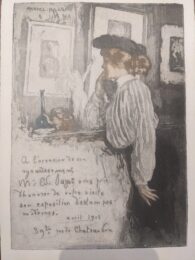


Emmanuel Robbe called “Manuel Robbe”, born in Paris on 16 December 1872 And died in Nesles-la-Vallée in 1936, is a French painter and engraver. Son of Alfred Auguste Charles Robbe and Marie Alphonsine Henry, the young Emmanuel Robbe studied at the Lycée Condorcet where he became friends with Gaston de Pawlowski , then joined the Lycee Louis-le-Grand , one of the La France. He then became a pupil of the Julian Academy where he met many personalities and then entered the Paris School of Fine Arts .
In November 1897, he had a son named Céline Bluem, known as “Maud” (1877-?), Also known as Manuel, and whom he recognized in 1899 with witnesses Jules Depaquit and Georges Delaw at the mayor of the 18th arrondissement of Paris . The couple divorced in 1911. Robbe quickly became an accomplished engraver specializing in the technique of aquatint .
He regularly exhibits in the salons of the Society of French Artists ; The Parisian merchants Edmond Sagot , Georges Petit and Pierrefort publish and disseminate his engraved works. In 1895, his poster for the oil lamp L’Éclatante is reproduced in the magazine Les Maîtres de l’affiche published by Jules Chéret (1895-1900). An engraving entitled Minuet of Autumn , is published in L’Estampe moderne (1897).
In 1900, at the Universal Exhibition , his work was awarded the bronze medal for an engraving entitled The summer (color etching of 25.5 × 40 cm ). His drawings are published in Cocorico (1898-1900) and Le Frou-frou (1901-1902). In 1905, the Galerie Georges Petit presented his works as part of a large exhibition entitled Original engravings in colors .
During his life as an artist, Manuel Robbe produces many aquatints , dry spikes , strong waters and some advertising posters as well as many unique works (oil on canvas, watercolors or pastels). An accomplished athlete, he is captain of the Fencing team of the Fine Arts, during the interprofessional championship of Paris in 1912.
During the war of 1914-1918 , when he was relieved of all obligations, he enlisted in the air force as a pilot and was awarded the war cross with quotations for his heroic feats of arms; Which explains why there are hardly any works dating from this period, but which is worth several engravings representing German and French military aircraft. Manuel Robbe’s works are a moving testimony to the lives of women and men of his time. Manuel Robbe loves to travel a lot and has a real attachment for Brittany that he has depicted on many occasions.
He died in 1936, after devoting a large part of his life to printmaking . He was buried in Nesles-la-Vallée ( Val-d’Oise ) where he had a second home.